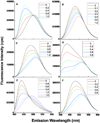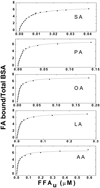Fatty acid-specific fluorescent probes and their use in resolving mixtures of unbound free fatty acids in equilibrium with albumin
- PMID: 17128966
- PMCID: PMC2519108
- DOI: 10.1021/bi060703e
Fatty acid-specific fluorescent probes and their use in resolving mixtures of unbound free fatty acids in equilibrium with albumin
Abstract
We report the first measurements for profiling mixtures of unbound free fatty acids. Measurements utilized fluorescent probes with distinctly different response profiles for different free fatty acids (FFA). These probes were constructed by labeling site-specific mutants of the rat intestinal fatty acid binding protein (rI-FABP) with acrylodan. The probes were produced and screened by high-throughput methods, and from more than 30 000 such probes we selected six that together have sufficient specificity and sensitivity for resolving the profile of unbound FFA (FFAu) in mixtures of different FFAu. We developed analytical methods to determine the FFAu profile from the fluorescence (ratio) response of the different probes and used these methods to determine FFAu profiles for mixtures of arachidonate, linoleate, oleate, palmitate, and stearate in equilibrium with bovine serum albumin (BSA). Measurements were performed using mixtures with a range of total FFAu concentrations, including 0.9 nM, which is similar to normal plasma levels. We also measured single FFA binding isotherms for BSA and found that binding was described well by six to seven sites with the same binding constants (Kd). The Kd values for the FFA (4-38 nM) were inversely related to the aqueous solubility of the FFA. We constructed a model with these parameters to predict the FFAu profile in equilibrium with BSA and found excellent agreement between the profiles measured using the FFA probes and those calculated with this model. These results should lead to a better understanding of albumin's role in buffering FFAu and to profiling FFAu in intra- and extracellular biological fluids.
Figures



Similar articles
-
Interactions of long-chain fatty acids and albumin: determination of free fatty acid levels using the fluorescent probe ADIFAB.Biochemistry. 1993 Jul 27;32(29):7574-80. doi: 10.1021/bi00080a032. Biochemistry. 1993. PMID: 8338853
-
Equilibrium constants for the binding of fatty acids with fatty acid-binding proteins from adipocyte, intestine, heart, and liver measured with the fluorescent probe ADIFAB.J Biol Chem. 1994 Sep 30;269(39):23918-30. J Biol Chem. 1994. PMID: 7929039
-
Unbound free fatty acid levels in human serum.J Lipid Res. 1995 Feb;36(2):229-40. J Lipid Res. 1995. PMID: 7751810
-
Acrylodan-labeled intestinal fatty acid-binding protein to measure concentrations of unbound fatty acids.Methods Mol Biol. 2007;400:27-43. doi: 10.1007/978-1-59745-519-0_3. Methods Mol Biol. 2007. PMID: 17951725 Review.
-
Mechanisms of cellular uptake of long chain free fatty acids.Mol Cell Biochem. 1999 Feb;192(1-2):17-31. Mol Cell Biochem. 1999. PMID: 10331655 Review.
Cited by
-
Two fatty acid-binding proteins expressed in the intestine interact differently with endocannabinoids.Protein Sci. 2020 Jul;29(7):1606-1617. doi: 10.1002/pro.3875. Epub 2020 Apr 28. Protein Sci. 2020. PMID: 32298508 Free PMC article.
-
Modeling Fatty Acid Transfer from Artery to Cardiomyocyte.PLoS Comput Biol. 2015 Dec 16;11(12):e1004666. doi: 10.1371/journal.pcbi.1004666. eCollection 2015 Dec. PLoS Comput Biol. 2015. PMID: 26675003 Free PMC article.
-
Effects of Soybean Lipid Infusion on Unbound Free Fatty Acids and Unbound Bilirubin in Preterm Infants.J Pediatr. 2017 May;184:45-50.e1. doi: 10.1016/j.jpeds.2016.12.026. Epub 2017 Jan 17. J Pediatr. 2017. PMID: 28108102 Free PMC article.
-
Usefulness of serum unbound free fatty acid levels to predict death early in patients with ST-segment elevation myocardial infarction (from the Thrombolysis In Myocardial Infarction [TIMI] II trial).Am J Cardiol. 2014 Jan 15;113(2):279-84. doi: 10.1016/j.amjcard.2013.08.057. Epub 2013 Oct 5. Am J Cardiol. 2014. PMID: 24176067 Free PMC article. Clinical Trial.
-
Beta-aminoisobutyric acid is released by contracting human skeletal muscle and lowers insulin release from INS-1 832/3 cells by mediating mitochondrial energy metabolism.Metabol Open. 2020 Aug 22;7:100053. doi: 10.1016/j.metop.2020.100053. eCollection 2020 Sep. Metabol Open. 2020. PMID: 32924003 Free PMC article.
References
-
- Goodacre R. Metabolomics - the way forward. Metabolomics. 2005;1:1–2.
-
- Cupp D, Kampf JP, Kleinfeld AM. Fatty acid:albumin complexes and the determination of long chain free fatty acid transport across membranes. Biochemistry. 2004;43:4473–4481. - PubMed
-
- Kampf JP, Kleinfeld AM. Fatty acid transport in adipocytes monitored by imaging intracellular FFA levels. J. Biol. Chem. 2004;279:35775–35780. - PubMed
-
- Richieri GV, Anel A, Kleinfeld AM. Interactions of long chain fatty acids and albumin: Determination of free fatty acid levels using the fluorescent probe ADIFAB. Biochemistry. 1993;32:7574–7580. - PubMed
Publication types
MeSH terms
Substances
Grants and funding
LinkOut - more resources
Full Text Sources
Other Literature Sources

